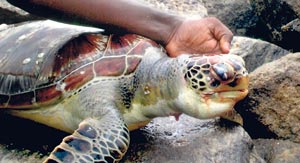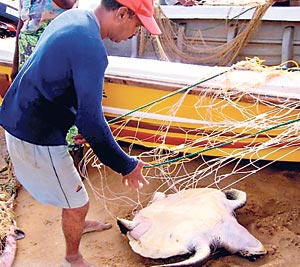Travelling to Colombo last Monday morning, the crowded office train was slowing down at the Wellawatta station, when I noticed a turtle on the beach. The turtle was surrounded by puzzled morning joggers who wanted to have a closer look at this unusual visitor.
Thinking it was still alive, I notified the Aquatic Group members of the Young Zoologists’ Association who conduct marine studies in this area. The Young Zoologists reached the site soon enough, but the turtle was dead and smelly, indicating that it could have died a few days earlier. It looked like an Olive Ridley Turtle from the pattern of its shell, said Sacheendra Deepankara who visited the site.
 |
| A Green turtle found on the Moratuwa beach on July 25 |
It seemed a one- off incident, but it was not. There are records that beaches in Mount Lavinia and Moratuwa are being used as nesting sites by some turtle species. According to the Young Zoologists more turtles have been washed ashore on the beaches from Panadura to Wellawatta these past few months.
“I have inspected seven turtles washed ashore on the Panadura and Moratuwa beaches during the last four months,” said Sameera Karunaratne, an instructor of the Reptiles Group of the Young Zoologists’ Association who also works for IUCN.
They have received information about more dead turtles from this area through reliable sources - the fishermen. This raised the total of dead turtles found within a short period to 17, an unusual number according to turtle experts.
This includes 11 Green turtles, 4 Hawksbill turtles and 2 Olive Ridleys.
Five turtle species - the Loggerhead Turtle (Caretta caretta), Green Turtle (Chelonia mydas), Leatherback Turtle (Dermochelys coriacea), Olive Ridley Turtle (Lepidochelys olivacea) and Hawksbill Turtle (Eretmochelys imbricata) visit Sri Lanka and many of them nest on Sri Lankan beaches.
Sameera who inspected the carcasses closely found no lethal wounds on the turtles’ bodies. Moreover, the shelsl of some of these ill-fated turtles were clean unlike that of wild turtles. This gave rise to the theory that these turtles could have been those reared in turtle hatcheries that have got notice to close down. Unable to survive on their own, the tank-raised turtles could have perished, increasing the number of dead turtles along this stretch of beach.
But the reality is that despite efforts by the Department of Wildlife Conservation, most of the turtle hatcheries down south are still fully operational.
The second, more acceptable theory is that these turtles could have died after getting entangled in fishermen’s nets. Turtles are marine reptiles that need to surface to breathe. They are often attracted to fishing nets, as they find trapped fish irresistible as readymade fast food. When they get caught in fishing nets and are unable to surface to breathe, they die. “I saved a few turtles entangled in fishing nets off Lunawa,” said Harshaka Priyankara, another member of the YZA who lives by the Lunawa beach.
 |
| Caught in the net: Pic courtesy Turtle Conservation Project |
It is also not an easy task to release a panicked turtle whose powerful bite can cause a severe injury.
Head of the Turtle Conservation Project (TCP) Thushan Kapurusinghe also believes these turtles might be victims of gill nets aimed at catching other fish.
He pointed out the likelihood of an increasing number of turtle deaths in the next few months as a mass migration through Sri Lankan waters is due. Some turtle species are known to migrate in large numbers and the Olive Ridleys mass migration to beaches in Orissa in India is recorded as the largest in the world.
Over 600,000 Olive Ridleys reach Gahirmatha and other beaches in Orissa state annually to lay eggs. Satellite tracking shows that a group of these migrants travel through the Gulf of Mannar toward the Bay of Bengal. So there can be a concentration of turtles in Sri Lankan waters from September until January/February next year. Unfortunately, this time frame also coincides with the local fishing season increasing the chance of lethal encounters.
“This is worst in the Kalpitiya area. Lots of turtles have died by getting entangled in fishing nets daily,” says Thushan.
TCP’s research boats stationed in Kandakuliya go out to sea every day with the fishermen and monitor the floating gill nets laid on the water by sailing close to them. When a turtle gets entangled, it frantically tries to lift its head looking for air.
If the researchers spot it, they have it carefully taken out. After taking measurements and recording the GPS locations of the turtle, they release it back to the sea.
This conservation project that was started three years ago has had some success.
TCP officers are now planning to monitor the effects of fishing in the path of Olive-Ridley’s mass migration this year.
The turtle is already a threatened species and though it is illegal to do so, some fishermen still kill turtles that get entangled in their fishing nets.
Can they be saved?
Heightened public effort may be vital in raising the alarm over this recent phenomenon. Turtle conservationists urge the public to be vigilant and report any dead turtle that had been seen during the past four months or that they may come across on beaches in future. Any such sightings could be emailed to turtles@sltnet.lk with the sender’s contact details. |
